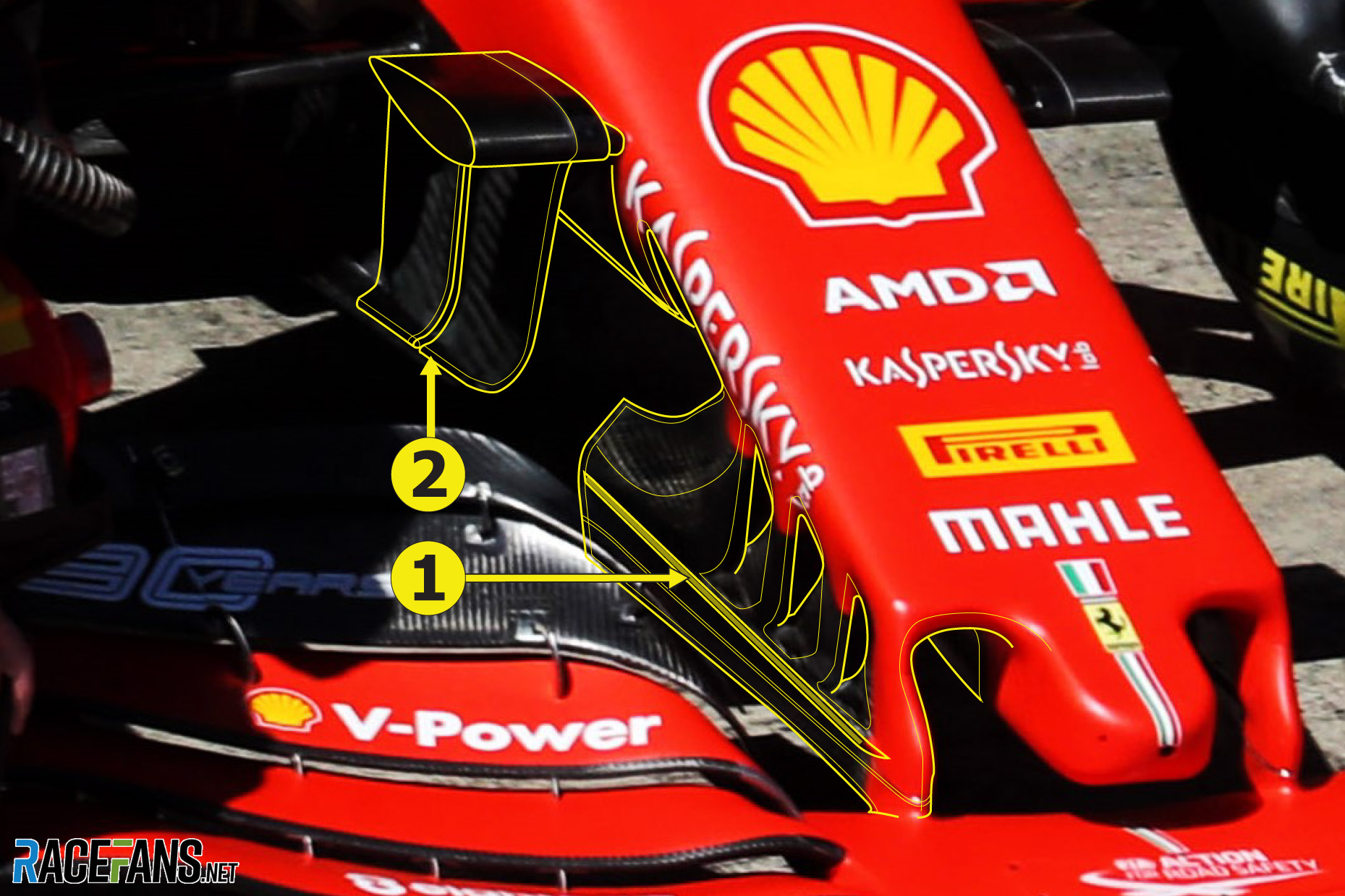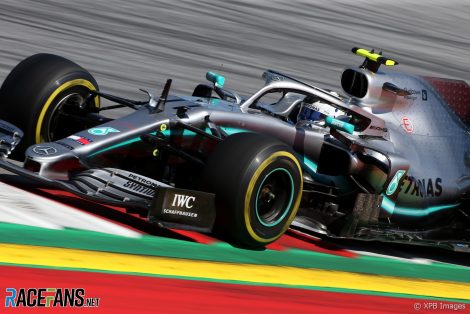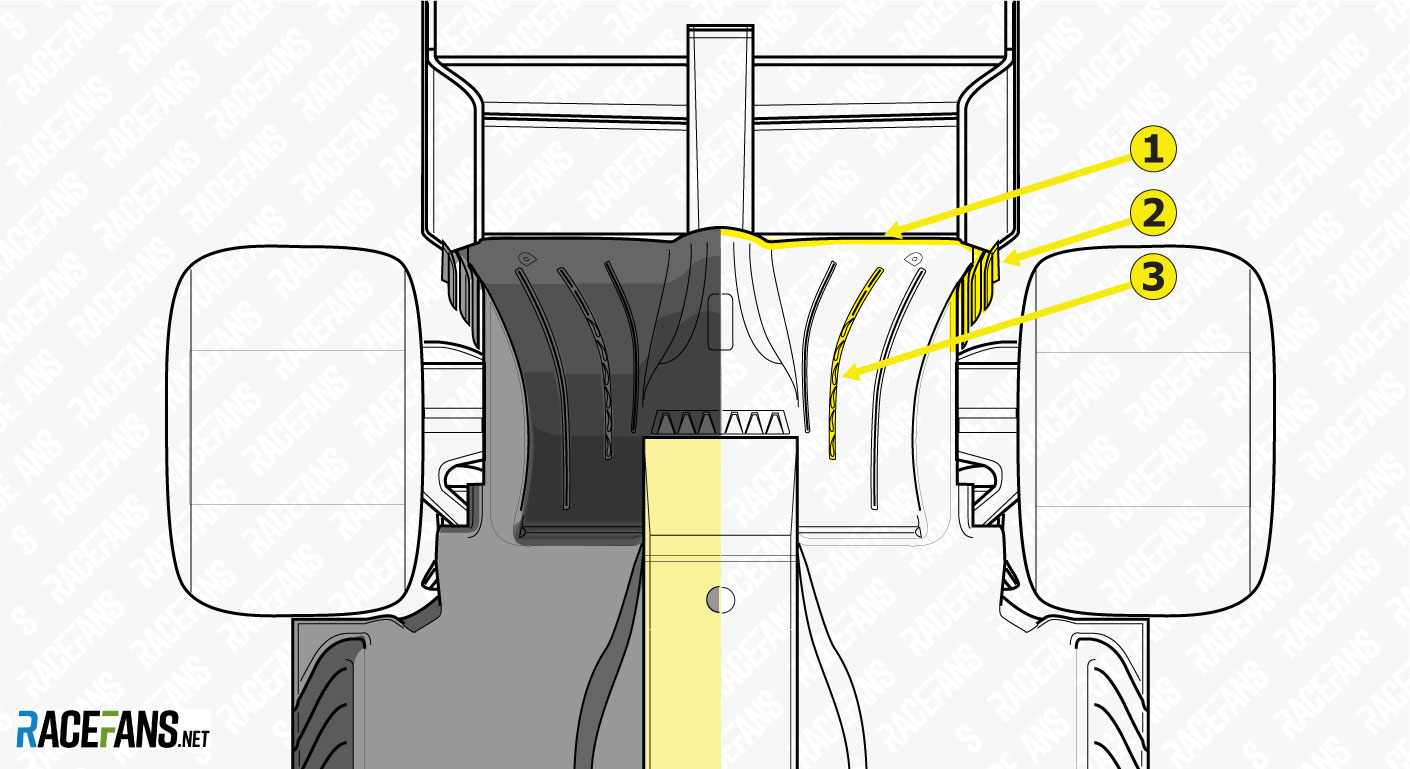The Austrian Grand Prix ended in disappointment again for Ferrari as for the third time this year a likely win got away from them in the final laps.
But had reason to draw encouragement from their car’s performance, especially over a single lap. Have Ferrari finally found the key to unlocking the pace of the SF90?The team has not shied away from admitting their car has failed to take the fight to Mercedes. As described previously, the root problem is they cannot consistently get the tyres into the optimum working range. Traction and cornering are consequently affected, costing lap time to Mercedes, despite Ferrari’s faster straight-line speeds.
While the interplay between the downforce level and suspension set-up lies at the heart of the problem, the greater proportion of blame has been placed upon the car’s aerodynamics. Ferrari went for a lower downforce and lower drag car, this concept is being reviewed by Ferrari and changes are being tested.
The first changes resulting from the reappraisal of the car have appeared in recent races. These aren’t a full fix but are probing areas of known weakness to see if the changes brings some improvement. A raft of updates appeared in France: front wing, brake ducts, floor edge and diffuser. Of these only the diffuser did not reappear in Austria. This has been viewed as a failure of the revised design, but the reality is that these were experiments, so even if they didn’t deliver on-track any lessons learnt will go back into the development loop.
Advert | Become a RaceFans supporter and
Ferrari’s French GP diffuser (above) was similar to Red Bull’s latest development. The outer corner was changed to pull more flow through the underfloor. Although Ferrari already has a three-element perimeter flap (1) around the diffuser, the shaping of the outer corner was more aggressive, the usual legality fin to meet the maximum height rule was removed and replaced by a diagonal strip connecting the flaps and positioned to meet the height rules.
The flaps also project forward (2) along the diffuser’s edge to work with the high pressure air above the floor and strength the vortex formed along the outer edge of the diffuser. Similar detail work is shown with the fences inside the diffuser, where the larger middle fence (3) has slots to add more energy and to direct the vortex shed from its lower edge.

In Austria there was only a revised nose vane package evident on the car. Ferrari run a series of slots in the front wing mounting pylon hanging from under the nose. These direct airflow inwards and direct it towards the front turning vanes just downstream of the pylons.
The package of changes included the nose pylon slots were made larger to ‘inwash’ more airflow towards the front turning vanes, which were rearranged with a second vane added behind the usual one (2). To endure the reshaped slots remain legal, there is a now long strip running underneath them (1).

As with all of these changes, this is not very significant on its own. But Ferrari’s path back to competitiveness is not about one major change, rather a series careful correction of many elements forming the car’s aero package.
Despite missing out on the win, Ferrari’s pace in Austria may not be the sole result of the aero upgrades, but a combination of the track layout and unusually hot weather. This may have flattered Ferrari, as Mercedes were clearly off the pace due to the effect the unique conditions had on its W10. With a more demanding circuit and typically cooler temperatures, the upcoming British Grand Prix at Silverstone will be a sterner test of Ferrari’s progress.
Advert | Become a RaceFans supporter and
F1 technology
- Pictures: Alpine’s new front wing and more Suzuka updates
- Pictures: Red Bull bring first performance upgrade for RB20
- How teams have tweaked their cars to hit higher speeds in Jeddah
- ‘A horrible project’: Why duplicating Red Bull’s trend-setting suspension is so difficult
- Aston Martin, Mercedes, Haas and others describe extensive US GP updates





GeeMac (@geemac)
9th July 2019, 14:00
Great piece again, thanks very much @scarbs.
Gabriel (@rethla)
9th July 2019, 15:36
If they have found the key they have shown nothing of it yet. In an odd Mercedes slump they still got beaten by a RB starting 8places back…
Denis
9th July 2019, 16:50
Although this looked like a Ferrari revival I can’t help but think that the Ferraris’ lack of pace was really striking. Although Bottas’ Mercedes was severely compromised by over heating he managed to maintain a 4 to 6 second gap to Leclerc. At first it looked like Leclerc was just managing the gap back to Bottas but when Max came chasing he was unable to pick up the pace and was easily caught. Vettel overtook Hamilton only after putting on fresh tyres even though Lewis’s car was really badly compromised by underside damage and the overheating problems as well as pretty worn tyres.
All in all everything in this race should have meant that Ferrari would have a huge advantage over the Mercedes but in fact it was marginal at best. The Red Bull’s pace on the other hand really was remarkable.
GechiChan (@gechichan)
10th July 2019, 8:13
also, people said that Max caught the Ferraris because RedBull forced their engine to higher outputs, not givving a damn about consequences and penalties further down the road. But I think Ferrari should have done the same, at least for Charles. A win for them would have been much more important than keping up with their reliability schedule.
Tifoso1989 (@tifoso1989)
9th July 2019, 17:29
Ferrari will bring further minor upgrades to Silverstone which will be the ultimate test to prove if the car concept need to be altered completely or just evolved incrementally. In Barcelona the SF90 was 0.8s slower than the W10, then it was 0.6s slower in France.
Silverstone with its fast corners is the circuit that emphasizes the most the W10 strengths, If Ferrari can reduce the gap to Mercedes in Silverstone then maybe their car is not as bad as some have suggested.
F1oSaurus (@)
9th July 2019, 18:25
@tifoso1989 Ferrari were faster in Bahrain, Baku, Canada and Austria. You can pretend they only gained 2 tenths from Barcelona to France, but that’s obviously not at all how any of this works.
Besides, it’s the slow corners where Mercedes was in general fastest.
Tifoso1989 (@tifoso1989)
9th July 2019, 18:35
@f1osaurus
You clearly missed the point, Ferrari’s design concept works very well in medium/low downforce tracks. I was talking about high downforce tracks when I referred to Barcelona/Paul Ricard.
That’s also down to the downforce advantage they have which is very useful in Silverstone, don’t you think so :)
F1oSaurus (@)
9th July 2019, 20:12
@tifoso1989 Your point just doesn’t make much sense. You mention a lot of unrelated items and press for a “point”.
The reality is that Ferrari performance is all over the place.
Besides:
– Paul Ricard is a medium downforce track.
– Slow corners is where Mercedes has the biggest advantage over the Ferrari, but slow corners are least depending on downforce. It’s mechanical grip which works there.
– Then you come with fast corners being good for Mercedes when Austria had plenty of those and Ferrari were much faster there
The only thing that makes sense is that Silverstone requires more downforce than average and that might potentially suit Mercedes better.
Although temperature probably has a bigger effect.
Tifoso1989 (@tifoso1989)
9th July 2019, 20:28
@f1osaurus
Yes indeed and spot on.
Downforce increases traction.
You forgot that cooling requirements have neutralized Mercedes in Austria and pushed them to open holes in the bodywork that lead them to lose their aero efficiency.
F1oSaurus (@)
10th July 2019, 11:31
@tifoso1989 In low speed coreners there is little downforce. So the effect is minimal. It’s mechanical grip which counts there
I have not forgotten that Mercedes had extra cooling requirements.
F1oSaurus (@)
9th July 2019, 18:23
In the race maybe, but Leclerc clearly had a big advantage over the Mercedes in Q3.
Ads Lee
9th July 2019, 19:01
Yeah because Mercedes couldn’t run their high engine modes.
F1oSaurus (@)
9th July 2019, 20:13
Over one lap they could
khm78 (@khm)
9th July 2019, 21:32
Maybe the enginemode was ok, but the bodywork had been opened up and the car was not nearly as efficient as it is normally….
Jon Bee
9th July 2019, 23:45
Has F1 engineering ever had to be this close before? An extra slot here and there turns a car into a winner. This only goes to show that the FIA/FOM need to stop changing the rules and allow the midfield teams to catch up with the top 2 teams. This has been shown by McLaren rising from the back to challenging the 2nd RB car regularly.
We might see the same rules for this year and next, but in 2021 it’ll all kick off again.
NS Biker (@rekibsn)
10th July 2019, 0:35
Great stuff Craig. Keep it up and rest assured that all of us enjoy the technical insights. In spite of the jousting that goes on, see above. Yes, entertaining and also informative.
Looking forward to a flurry of pre-break upgrades across all or most of the teams.
Thanks again.
Mark in Florida
10th July 2019, 1:45
I don’t know if it’s all down to Ferraris aero package. I think they are at the point now that they will try anything. A little bit of Red Bull aero and a little bit of Merc aero. Whatever seems to work because the low drag setup just doesn’t work as well for race pace. I think even if their package was closer to Mercs with Ferraris supposedly better engine they still wouldn’t win as often as you think. Ferrari continues to falter with race strategy and when circumstances change in a race they are either slow to respond or respond with an incorrect call on pit order or tires. If Merc had Ferraris cars and Ferrari had Mercs I think the results would basically be the same as now. Merc has the better team management and a better driver in Lewis.